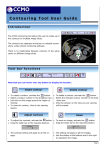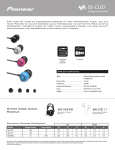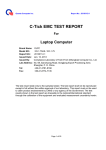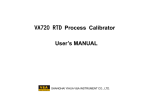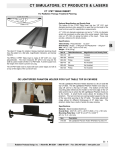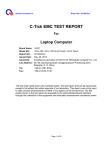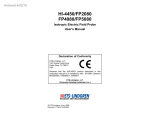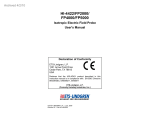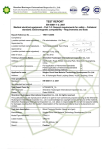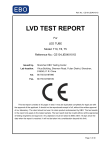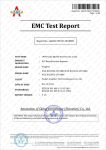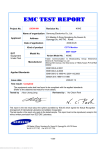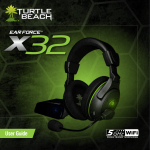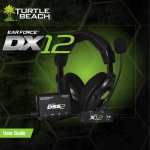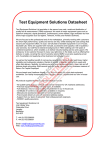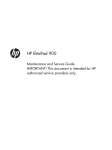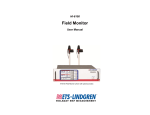Download CE11-LIE090126E-LED Spotlight-AR111
Transcript
Shenzhen EBO Testing Center Report No. CE11-LIE090126E EMC TEST REPORT Report No.: CE11-LIE090126E Product: LED SPOT LIGHT Model No.: CE-15W5000K-AR3002, CE-15W3000K-AR3001 Applicant: SHEN ZHEN C.E OPTOELECTRONIC.CO., LTD Address: A BLOCK, SHENG YANG TECHNOLOGY PARK, DA FU INDUSTRIAL AREA, GUAN LAN TOWN, BAO AN DISTRICT, SHEN ZHEN, CHINA Issued by: Shenzhen EBO Testing Center Lab Location: Yihua Building, Shennan Road, Futian District, Shenzhen, 518040, P. R. China Tel: 86 755 29451282 Fax:86 755 22639141 This test report consists of 16 pages in total. It may be duplicated completely for legal use with the approval of the applicant. It should not be reproduced except in full, without the written approval of our laboratory. The client should not use it to claim product endorsement by EBO. The test results in the report only apply to the tested sample. The test report shall be invalid without all the signatures of testing engineers, reviewer and approver. Any objections must be raised to EBO within 15 days since the date when the report is received. It will not be taken into consideration beyond this limit. Page 1 of 16 Shenzhen EBO Testing Center Report No. CE11-LIE090126E Table of Contents 1 2 Test Report Certification ...............................................................................................................3 General Information ......................................................................................................................4 2.1 Description of EUT ...............................................................................................................4 2.2 Objective ...............................................................................................................................4 2.3 Test Standards and Results ....................................................................................................5 2.4 List of Equipments Used.......................................................................................................6 3 Emission Test ................................................................................................................................7 3.1 EUT Setup and Operating Conditions...................................................................................7 3.2 Radiated Electromagnetic Disturbance Measurement ..........................................................7 3.2.1 Limits of Radiated Electromagnetic Disturbance ......................................................7 3.2.2 Test Procedure ............................................................................................................7 3.2.3 Test Setup ...................................................................................................................8 3.2.4 Test Results ................................................................................................................8 4 Immunity Test ............................................................................................................................. 11 4.1 EUT Setup and Operating Conditions................................................................................. 11 4.2 Performance Criteria ........................................................................................................... 11 4.3 Electrostatic Discharge Immunity Test ............................................................................... 11 4.3.1 Test Specification ..................................................................................................... 11 4.3.2 Test Procedure ..........................................................................................................12 4.3.3 Test Setup .................................................................................................................13 4.3.4 Test Result ................................................................................................................13 4.4 Radiated, Radio Frequency Electromagnetic Field Immunity Test ....................................14 4.4.1 Test Specification .....................................................................................................14 4.4.2 Test Procedure ..........................................................................................................14 .4.3 Test Setup ...................................................................................................................15 4.4.4 Test Result ................................................................................................................15 Appendix I:Photographs of the EUT..............................................................................................16 Page 2 of 16 Shenzhen EBO Testing Center 1 Report No. CE11-LIE090126E Test Report Certification Product: LED SPOT LIGHT Model No.: CE-15W5000K-AR3002, CE-15W3000K-AR3001 Applicant: SHEN ZHEN C.E OPTOELECTRONIC.CO., LTD Applicant Address: A BLOCK, SHENG YANG TECHNOLOGY PARK, DA FU INDUSTRIAL AREA, GUAN LAN TOWN, BAO AN DISTRICT, SHEN ZHEN, CHINA Manufacturer: SHEN ZHEN C.E OPTOELECTRONIC.CO., LTD Manufacturer Address: A BLOCK, SHENG YANG TECHNOLOGY PARK, DA FU INDUSTRIAL AREA, GUAN LAN TOWN, BAO AN DISTRICT, SHEN ZHEN, CHINA Test Standards: EN 55015:2006+A1:2007+A2:2009 EN 61547:2009 Test Result: PASS We, Shenzhen EBO Testing Center, hereby certify that the submitted samples of the above item, as detailed in chapter 2.1 of this report, has been tested in our facility. The test record, data evaluation and test configuration represented herein are true and accurate accounts of measurements of the sample’s EMC characteristics under the conditions herein specified. Tested by: , Date: September 22, 2011 Smart Li , Approved by: Date: September 22, 2011 Kevin Yu Page 3 of 16 Shenzhen EBO Testing Center 2 Report No. CE11-LIE090126E General Information 2.1 Description of EUT Product: LED SPOT LIGHT Model No.: CE-15W5000K-AR3002 Brand Name: / Electrical Rating: 12V, 15W I/O Ports: / Accessories: / NOTE: 1. Please refer to Appendix I for the photographs of the EUT. For more detailed features description about the EUT, please refer to User’s Manual. 2.2 Objective Perform ElectroMagnetic Interference (EMI) and ElectroMagnetic Susceptibility (EMS) tests for CE Marking. Page 4 of 16 Shenzhen EBO Testing Center Report No. CE11-LIE090126E 2.3 Test Standards and Results The EUT has been tested according to the following specifications: EMISSION Standard EN55015:2006+A1:2007+A2:2 009 Test Type Radiated Electromagnetic Disturbance Result PASS Measurement IMMUNITY (EN61547:2009) Basic Standard Test Type Result EN 61000-4-2 Electrostatic discharge immunity PASS EN 61000-4-3 Radiated, radio frequency electromagnetic field immunity PASS NOTE: The latest versions of basic standards are applied. Page 5 of 16 Shenzhen EBO Testing Center Report No. CE11-LIE090126E 2.4 List of Equipments Used Description Manufacturer Model No. Serial No. Test Receiver Schwarzbeck FCKL1528 A0304230 LISN Schwarzbeck NSLK8127 A0304233 Loop Antenna Schwarzbeck HXYZ8170 A0304232 Amplifier Research AR AT1080 A0304249 Power Frequency Test System HAEFELY PHF 555 A0103105 ESD Test System HAEFELY FESD16000 A0103108 Signal Generator ROHDE&SCHWARZ SML02 A0304261 Power Amplifier Amplifier Research AR 150W1000 A0304247 Power Amplifier Amplifier Research AR 75A250M A0304255 Field Monitor Amplifier Research AR FM5004 305128 Magnetic Field Tester HAEFELY MAG 100.1 A0103109 Shield Room Nanbo Tech Site 3 A9901141 Shield Room Nanbo Tech Site 1 A0304210 Antenna NOTE: Equipments listed above have been calibrated and are in the period of validation. Page 6 of 16 Shenzhen EBO Testing Center 3 Report No. CE11-LIE090126E Emission Test 3.1 EUT Setup and Operating Conditions The EUT was power by DC 12V Mains. 3.2 Radiated Electromagnetic Disturbance Measurement 3.2.1 Limits of Radiated Electromagnetic Disturbance Frequency range (MHz) QP Limits(dBμΑ), for loop antenna with a diameter of 2m 0.009 to 0.07 88 0.07 to 0.15 88 to 58 0.15 to 2.2 58 to 26 2.2 to 3.0 58 3.0 to 30 22 Notes: (1) The lower limit shall apply at the transition frequency. (2) The limit decreases linearly with the logarithm of the frequency in the range 70 kHz to 150kHz. (3) The limit increases linearly with the logarithm of the frequency in the range 150 kHz to 2.2MHz. 3.2.2 Test Procedure a. The magnetic component of radiated electromagnetic disturbance is measured by means of a loop antenna. b. The induced current in the loop antenna is measured by means of a current probe (1V/A) and the CISPR measuring receiver. By means of a coaxial switch, the three field directions are measured in sequence. c. The EUT was placed in the center of the loop antenna, on an insulated table. Page 7 of 16 Shenzhen EBO Testing Center Report No. CE11-LIE090126E 3.2.3 Test Setup For the actual test configuration, please refer to the related item-Photographs of the Test Configuration. 3.2.4 Test Results No. Antenna Direction Frequency (MHz) QP Limits (dBμA) Emission Level (dBμΑ) 1 X/Y/Z 0.009-0.07 88 <30 2 X/Y/Z 0.07-0.15 88-58 <30 3 X/Y/Z 0.15-2.2 58-26 <20 4 X/Y/Z 2.2-3.0 58 <20 5 X/Y/Z 3.0-30 22 <10 Page 8 of 16 Shenzhen EBO Testing Center Report No. CE11-LIE090126E 1.Radiated electromagnetic disturbance, loop antenna direction: X 2.Radiated electromagnetic disturbance, loop antenna direction: Y Page 9 of 16 Shenzhen EBO Testing Center Report No. CE11-LIE090126E 3.Radiated electromagnetic disturbance, loop antenna direction: Z Page 10 of 16 Shenzhen EBO Testing Center 4 Report No. CE11-LIE090126E Immunity Test 4.1 EUT Setup and Operating Conditions Same as 3.1 4.2 Performance Criteria Criterion A During the test no change of the luminous intensity shall be observed and the regulating control, if any, shall operate during the test as intended. During the test the luminous intensity may change to any value. After the test the luminous intensity shall be restored to its initial value within 1 minute. Criterion B Regulating controls need not function during the test, but after the test the mode of the control shall be the same as before the test provided that during the test no mode changing commands were given. During and after the test any change of the luminous intensity is allowed and the lamp(s) may be extinguished. After the test, within 30 minutes, all functions shall return to normal if necessary be by temporary interruption of the mains supply and/or operating the regulating Criterion C control. Additional requirement for lighting equipment incorporating a starting device: After the test the lighting equipment is switch off. After half an hour it is switched on again. The lighting equipment shall start and operate as intended. 4.3 Electrostatic Discharge Immunity Test 4.3.1 Test Specification Basic Standard: Discharge Impedance EN 61000-4-2 330Ω / 150 pF Discharge Voltage: Air Discharge – 8 kV Contact Discharge – 4 kV Polarity: Positive / Negative Number of Discharge: Minimum 20 times at each test point Discharge Mode: Single discharge Discharge Period: 1-second minimum Page 11 of 16 Shenzhen EBO Testing Center Report No. CE11-LIE090126E 4.3.2 Test Procedure The discharges shall be applied in two ways: a. Contact discharges to the conductive surfaces and coupling planes: The EUT shall be exposed to at least 200 discharges, 100 each at negative and positive polarity, at a minimum of four test points. One of the test points shall be subjected to at least 50 indirect discharges to the center of the front edge of the horizontal coupling plane. The remaining three contact test points shall each receive at least 50 direct contact discharges. If no direct contact test points are available, at least 200 indirect discharges shall be applied in the indirect mode. Test shall be performed at a maximum repetition rate of one discharge per second. b. Air discharges at slots and apertures and insulating surfaces: On those parts of the EUT where it is not possible to perform contact discharge testing, the equipment should be investigated to identify user accessible points where breakdown may occur. Such points are tested using the air discharge method. This investigation should be restricted to those area normally handled selected test point for each such area. The basic test procedure was in accordance with EN 61000-4-2: a. Electrostatic discharges were applied only to those points and surfaces of the EUT that are accessible to users during normal operation. b. The test was performed with at least ten single discharges on the pre-selected points in the most sensitive polarity. c. The time interval between two successive single discharges was at least 1 second. d. The ESD generator was held perpendicularly to the surface to which the discharge was applied and the return cable was at least 0.2 meters from the EUT. e. Contact discharges were applied to the non-insulating coating, with the pointed tip of the generator penetrating the coating and contacting the conducting substrate. f. Air discharges were applied with the round discharge tip of the discharge electrode approaching the EUT as fast as possible (without causing mechanical damage) to touch the EUT. After each discharge, the ESD generator was removed from the EUT and re-triggered for a new single discharge. The test was repeated until all discharges were completed. g. At least ten single discharges (in the most sensitive polarity) were applied to the Horizontal Coupling Plane at points on each side of the EUT. The ESD generator was positioned Page 12 of 16 Shenzhen EBO Testing Center Report No. CE11-LIE090126E vertically at a distance of 0.1 meters from the EUT with the discharge electrode touching the HCP. h. At least ten single discharges (in the most sensitive polarity) were applied to the center of one vertical edge of the Vertical Coupling Plane in sufficiently different positions that the four faces of the EUT were completely illuminated. The VCP (dimensions 0.5m×0.5m) was placed vertically to and 0.1 meters from the EUT. 4.3.3 Test Setup 4.3.4 Test Result Discharge Level (kV) Discharge Mode Observation Comply with Criterion HCP ±4 Contact Note(1) A VCP LED lamp ±4 Contact Note(1) A ±4, ±8 Air Note(1) B Test Points NOTE: (1). The EUT continued to operate as intended. No degradation of performance was observed.. Page 13 of 16 Shenzhen EBO Testing Center Report No. CE11-LIE090126E 4.4 Radiated, Radio Frequency Electromagnetic Field Immunity Test 4.4.1 Test Specification Basic Standard: EN 61000-4-3 Frequency Range: 80 MHz – 1000MHz Field Strength: 3V/m Modulation: 1kHz sine wave, 80%, AM modulation Frequency Step: 1% of fundamental Polarity of Antenna Horizontal and Vertical Test Distance: 3m Antenna Height: 1.5m Dwell Time: 3 seconds 4.4.2 Test Procedure The test procedure was in accordance with EN 61000-4-3. a. The testing was performed in a fully anechoic chamber. The transmit antenna was located at a distance of 3 meters from the EUT. b. The frequency range is swept from 80 MHz to 1000MHz with the signal 80% amplitude modulated with a 1 kHz sine wave. The rate of sweep did not exceed 1.5×10-3 decade/s. Where the frequency range is swept incrementally, the step size was 1% of fundamental. c. The dwell time at each frequency shall be not less than the time necessary for the EUT to be able to respond. d. The field strength level was 3V/m. e. The test was performed with the EUT exposed to both vertically and horizontally polarized fields on each of the four sides. Page 14 of 16 Shenzhen EBO Testing Center Report No. CE11-LIE090126E 4.4.3 Test Setup 4.4.4 Test Result Frequency Field Strength (V/m) Observation Comply with Criterion Polarity Azimuth 80-1000 MHz V&H 0 3 Note(1) A 80-1000 MHz V&H 90 3 Note(1) A 80-1000 MHz V&H 180 3 Note(1) A 80-1000 MHz V&H 270 3 Note(1) A NOTE: (1). The EUT continued to operate as intended. No degradation of performance was observed. Page 15 of 16 Shenzhen EBO Testing Center Report No. CE11-LIE090126E Appendix I:Photographs of the EUT (EBO authenticate the photo on original report only) *** End of Report *** Page 16 of 16
















